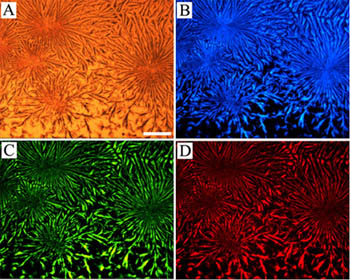| |
The unique optical and optoelectronic properties as well as the prospective applications in nanoscale devices have sparked a wide investigation activity on organic nanomaterials. Most of the works, however, have been focused on zero-dimensional (0D) organic nanoparticles with amorphous structures. Compared with their 0D counterparts, one-dimensional (1D) nanomaterials are more suitable for the construction of active nanodevices and interconnect. In their recent works, Prof. Jiannian Yao and co-workers developed an adsorbent-assisted physical vapor deposition (PVD) method for the fabrication of crystalline organic nanowires with single composition, in which the introduction of adsorbents was proven to be indispensable for improving the uniformity of the products (see Chem. Mater. 2006, 18, 2302-2306; Adv. Funct. Mater. 2006, 16, 1985-1991).
Recently, with supports of the National Natural Science Foundation and Chinese Academy of Science, they prepared the crystalline 1D nanomaterials and their hierarchical assemblies based on a low-molecular-weight organic compound, 1,2,3,4,5-pentaphenyl-1,3-cyclopentadiene (PPCP). After being fabricated to crystalline nanoribbon assemblies, PPCP displayed multicolor emission property, i.e., blue, green, and red emissions will be achieved respectively by exciting the same sample with appropriate wavelengths (Adv. Mater. 2007, 19, 3554-3558).
They also extended the adsorbent-assisted PVD method to doped binary organic systems. Uniformly doped crystalline nanorods and nanowires were prepared with 1,3,5-triphenyl-2-pyrzoline (TPP) as energy donor and rubrene as energy acceptor. Intermolecular fluorescence resonance energy transfer was observed in the doping system, based on which the emission color of the binary nanomaterials can be readily tuned by modulating the molar ratio of the two compounds. White-light emission was obtained when proper TPP:rubrene molar ratio was adopted. (Adv. Mater. 2007, 19, published online).
Adv. Mater. (2007, 19, 3554-3558)

Bright-field image and fluorescence microscopy images of the PPCP nanoribbon assemblies excited with different wavelengths. Scale bar is 10 μm. , |
|
